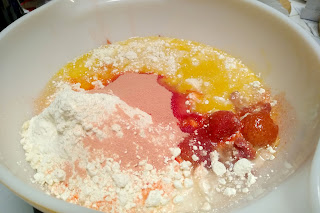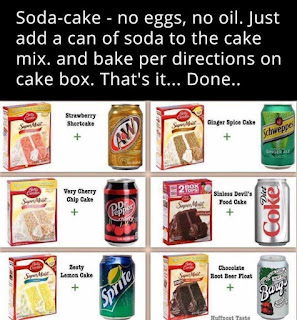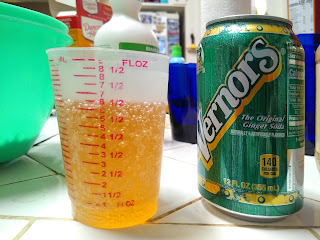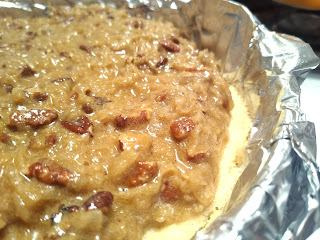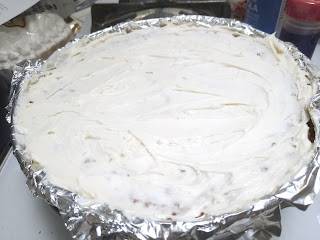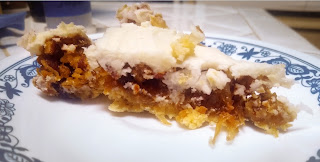Sometimes a recipe keeps coming to you from different places.
A friend of my parents' made a strawberry cake as one of her signature birthday cake for all of her kids' parties (and we went to a lot of them). Then one year my mother found a printed copy of a similar recipe somewhere else and asked me to make it for... some occasion or another. I forget what the occasion was, but I ended up making something else. Then, my mother came back from visiting her mother, and my grandmother had sent this recipe back an index card in her mother's handwriting. She also sent me her mother's silver cake server.
|
Strawberry Cake 1 box white cake mix 3 tbsp flour 1 box strawberry gelatin (I used a 3-oz one) 1 (10-oz) box frozen strawberries-- thawed, drained, and divided in half 1 c cooking oil ½ c cold water 4 eggs Heat oven to 375°. Grease a 9"x13" pan. Mix half the strawberries (and the juice you drained off of them) and everything else together. You might want to first put the strawberries through a blender unless you're using a two-beater mixer which will chop them up anyway. Pour into the pan and bake 30-40 minutes. Icing: ⅓ c margarine ¾ package of powdered sugar* Remaining half box of frozen strawberries We will have to revisit this recipe before we can with assurance write directions that work, see below. *Some powdered sugar packages are 1 pound, some are 2 pounds. This icing recipe appears most likely to work with the latter size. Source: Handwritten recipe card
|
Well fine, if this recipe is going to keep bumping into my life, I can't do anything besides make it.
This is not from the pen of the same great-grandmother whose graham cracker and coconut cake we made not too long ago. Today's recipe comes from the same great-grandmother whose fudge recipe you can find on the back of a marshmallow creme jar. We've also used her hand-cranked egg beater in the process of baking for my grandmother's bake sale.
When I got this recipe, I thought it would be cute to bring this to the next family gathering. Wouldn't it be so lovely, I thought, to serve my great-grandmother's cake with her own cake spatula? Unfortunately, I then put the card somewhere so safe that even I couldn't touch it. But as evidenced by the fact that we're making the cake today, I later found the card and photographed it before putting it somewhere easier to remember.
Well that looks easy enough. Like a lot of recipes that start with a box of cake mix, I figured the instructions consisted of putting everything in the bowl and letting your electric mixer do the rest. If you use a mixer that has a single paddle instead of two beaters, this may not work for you because the two beaters kind of chop up the strawberries as they go. You might have to do some scissor-snipping (or blenderizing) of strawberries before putting them in.
As a recipe note, we have a lot of olive oil, margarine, and also a surprising amount of beef fat. This house is well-stocked with various fats, and I was not about to add cooking oil to them. Therefore we're using melted margarine instead of the specified cooking oil in this recipe. It's always more economical to use what you already have.
As a second recipe note, I didn't know how big the "1 box frozen strawberries" we're supposed to put in this cake is supposed to be. An image search for boxes of frozen strawberries shows that they're all ten ounces. Since every single box of frozen strawberries we found online was the same size, I think we can safely assume that 10 ounces is the standard size of a box of frozen strawberries. All of the strawberries I saw in the freezer aisle were bags of individually-frozen berries, but I figured that it would make no difference whether the berries had been frozen separately or pressed into a 10-ounce block before freezing. You can't tell the difference when they thaw anyway.
Having gotten everything into the bowl, we let the mixer do its electrical magic and turn these disparate ingredients into a cake batter.
I love how pink this is! I know it's mostly the artificial red dye in the Jello that gives it that perfect hue, but I also don't care.
Like I said earlier, this particular copy of the recipe is in my great-grandmother's handwriting but the recipe has found me multiple times before I ever knew she wrote it down. She attributes it to a friend of hers on the top right corner of the card. My point is, this recipe has gotten passed around a lot. Perhaps it's not in as many recipe boxes as the cookie recipe on the back of the chocolate chip bag, but it seems like this cake recipe has remained popular much longer than the corporate test kitchen thought it would.
I really wanted to know where this recipe first came from. But so many people have shared this recipe online that I couldn't find who might have first published it. It's probably from the 1950s or 60s, when a lot of creative cake mix recipes flew out of test kitchens to help people feel less lazy for making dessert without measuring out flour. Since we have Wesson Oil named on the card, it might be from that company. Or maybe for people of a certain era or region, Wesson Oil is a general term like Crisco or Xerox.
If you make this at home, I suggest you add the water after everything else is mixed. The batter is so thin that the last little lumps of cake mix can stubbornly evade any attempts to mix them.
After meaning to make this recipe for a while, it was quite anticlimactic how quickly we went from putting the first things into the mixing bowl to putting the cake into the oven. The cake is an ordinary-looking brown on top, but you could see that it was still wonderfully pink in the middle.
And now, we move on to the icing. The ingredients tell us to use "3/4 package" of powdered sugar. It's either the one-pound boxes of powdered sugar that used to be the standard, or the two-pound bags that you find nowadays. I guessed that the "3/4 package powdered sugar" in the recipe is meant to be three-fourths of a one-pound box. This may not have been correct, as we will shortly see.
Things start out like most icings do, with the powdered sugar in a nest of oleo. It soon looks like any buttercream before you thin it out a bit.
Here we make our grave mistake: we just dumped the strawberries in. In retrospect, we should have drained the juice into the cake batter instead saving it for the icing (you'll see why).
As before, the mixer did all the fruit-chopping for us. However, it soon became apparent that the icing had too much strawberry juice in it. I could live with icing that was a tad runny, but today our icing had re-separated into oleo curds suspended in strawberry syrup.
Ordinarily, one might keep adding powdered sugar until the butter-curd soup turns back into icing, but it soon became obvious that I would have to use up all the powdered sugar in the house to fix this mess. So instead, I poured a fresh bowl of powdered sugar and slowly dribbled in the buttery red goop until the mixture looked right.
This resulted in some adorably pink icing with strawberry speckles. It also had an absolutely wonderful strawberry flavor. Clearly I got the original amounts wrong, but I'd definitely recommend this icing to anyone who can get it right the first time.
Our icing misadventure also resulted in a bag of strawberry-oleo failure which I froze away. I figured I can reconstitute it with extra powdered sugar at some point in the future. That way, instead of waste, we can have delicious strawberry icing twice. Also, strawberries are not cheap regardless of whether you get them fresh or frozen.
 |
| This is what cheapskatery looks like. |
Before we step away from the icing, I have one further quick note. You may think that the icing would work if you melted it. I thought so too, and put the unused strawberry-oleo mess in the microwave to find out. The butter merely floated on top- but this time in liquid form.
I thought that perhaps the icing would mix if it got put through a blender. True, anyone who paid attention in science class would know that oil and water do not mix. But you may remember that the honey fruit dressing resisted mixing until it got a very hard whisking, but never separated (even after a few days) after we got it combined.
This turned into a decent looking glaze after blenderizing it. And even after leaving it out for a few minutes to watch for any re-stratification, it looked like it would decisively stay mixed. However, it tasted like you were eating a stick of butter with strawberries on top. Therefore, I'm inclined to say that we should have used a two-pound bag of powdered sugar, not the single-pounder that we used today. But of course, that would make a lot of icing-- so much that if you put all of it on one cake it would collapse in a sweet swamp. I think it might have worked had I drained the strawberry juice into the cake batter instead of the icing.
And so, after an unexpected near-failure, we finally reach that magical point where we mate the salvaged icing to the cake! I think it's an extra-special moment when you're topping a cake with an icing that specifically came with it in the recipe. It feels more satisfying than arbitrarily picking an icing for a cake that doesn't have its own designated one.
This icing was almost but not quite runny enough to be a glaze. If you wanted
it to be a bit less drippy, you would probably have to cheat a bit and
add a tablespoon or two of shortening. In its current form, the icing spread in just a few seconds. However, it really did need to sit out overnight to firm up enough to forestall pink drips. Nevertheless, I absolutely loved the pink and strawberry-speckled result. I don't know why the camera's doing its best to make this look bad.
I will admit it's not much to look at. The icing, no matter how evenly you spread it, looks like a dumped-on slick with unfortunate chunks. Perhaps employing a blender would improve it, but I think your best bet would be to cut the cake up before serving it. The same strawberry chunks that add an unfortunate appearance to the uncut cake turn into cute flecks and speckles on an individual slice.
 |
| I would like to point out that no red food coloring went into the icing. The strawberries turned it pink unassisted. |
Opinion was divided on the bright color. Some people thought it looked really cute, others thought it looked, and I quote, "radioactive."
This is one of the few "dress up a cake mix" recipes I'd actually make
again. I think adding actual strawberries to the batter fixed a lot
of the bland artificiality of the cake mix. I carefully tried some of
the cake with no icing on top, and it's just a bit lighter and more
delicate-textured than most cake mixes. The strawberry flavor is
perfect. The icing is of course really good after correcting for some
very severe mistakes. I would make it again for any cake--- or at least, any cake you serve right out of the pan. It would look drippy (and not in that cute drizzly way) on a layer cake.
With that said, the last three words of the recipe, "very rich cake," are very correct. If you're not making this for a lot of people, I would suggest measuring out half of the cake mix and then making half the recipe. However, we did eat the whole thing.

